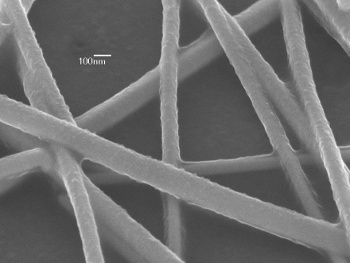Silver Nanowire Transparent Electrodes
December 19, 2011
Materials that are
transparent at
visible wavelengths and
electrically conductive are important for
display screens and
photovoltaics.
Indium-tin oxide (ITO, typical composition 90%
In2O3 and 10%
SnO2 by weight) is the most popular material for these applications, but
indium is becoming scarce and expensive.
I reviewed the worldwide shortage of indium in two previous articles,
"Indium," January 8, 2008, and
"Transparent and Conductive," June 10, 2011. In 2010, the estimated world consumption of indium was 120
metric tons at an average price of about $560/
kg.[1-2] It's no wonder that
materials scientists are researching ITO replacements.
At this time, there are a few alternatives to ITO, although they all fall short in one way or another. The table below lists the prime contenders.
Scientists with the
Department of Materials Science & Engineering, the
California NanoSystems Institute, and the
Department of Chemistry & Biochemistry of the
University of California, Los Angeles, (UCLA) have found that a surface coating of
silver nanowires, overcoated with a conductive polymer, forms a good quality transparent electrode when subjected to an intermediate processing step.[9-10] The UCLA team was led by material scientists,
Yang Yang and
Paul Weiss.[9]
Silver nanowires have been investigated for this application, before, since the wires are highly conductive and they are flexible enough to be used in flexible displays. One essential processing step in previous studies was a treatment to fuse the nanowires together where they cross as a way to enhance electrical conductivity and adherence to the
substrate material.[9-10] One treatment method is an
anneal at 200°C.[9]
The UCLA team was able to produce highly conductive silver nanowire films by first applying a
TiO2 sol-gel coating to silver nanowire films formed by solution spraying. As
solvent evaporated from the
titania precursor,
capillary forces drew the nanowires closer together, making the nanowire layer more conductive. Then a
PEDOT:PSS (poly(3,4-ethylenedioxythiophene) poly(styrenesulfonate)) coating was applied to act as a protective layer and an adhesion promoter.[10]

A scanning-electron micrograph of a silver nanowire transparent conducting film.
(UCLA image).[9])
The UCLA research team fabricated
photovoltaic cells with the silver nanowire electrodes. The performance of these cells was comparable to that of photovoltaics made with from indium tin oxide.[9-10] The UCLA research was supported by the
Office of Naval Research and the
Kavli Foundation.[9]
Team leader, Yang Yang, offered this summary of the work.
"In this work, we demonstrate a simple and effective solution method to achieve highly conductive AgNW composite films with excellent optical transparency and mechanical properties... This is by far the best solution: a processed, transparent electrode that is compatible with a wide variety of substrate choices."[9]
References:
- US Geological Survey, Indium - USGS Mineral Resources Program, Mineral Commodity Summaries, 2011.
- Amy C. Tolcin, "Indium," U.S. Department of the Interior, U.S. Geological Survey, Mineral Commodity Summaries 2011, p. 74.
- S.-J. Jiang, Z.-C. Jin, and Claes G. Granqvist, "Low-refractive-index indium-tin-oxyfluoride thin films made by high-rate reactive dc magnetron sputtering," Appl. Opt. vol. 27, no. 14 (July 15, 1988), 2847-2850.
- W. Tanga and D.C. Camerona, "Aluminum-doped zinc oxide transparent conductors deposited by the sol-gel process," Thin Solid Films, vol. 238, no. 1 (January 15, 1994), pp. 83-87.
- Xiaonan Li, Timothy A. Gessert and Timothy Coutts, "The properties of cadmium tin oxide thin-film compounds prepared by linear combinatorial synthesis, Proceedings of the Second Japan-US Workshop on Combinatorial Materials Science and Technology, Applied Surface Science, vol. 223, no. 1-3, February 15, 2004, pp. 138-143.
- Katsuro Hayashi, Satoru Matsuishi, Toshio Kamiya, Masahiro Hirano and Hideo Hosono, "Light-induced conversion of an insulating refractory oxide into a persistent electronic conductor," Nature, vol. 419, no. 6906 (October 3, 2002), pp. 462-465.
- Ivo Jongsma, "Researchers find replacement for rare material indium tin oxide," Eindhoven University of Technology Press Release, April 11. 2011.
- Andriy V. Kyrylyuk, Marie Claire Hermant, Tanja Schilling, Bert Klumperman, Cor E. Koning and Paul van der Schoot, "Controlling electrical percolation in multicomponent carbon nanotube dispersions," Nature Nanotechnology (Published online April 10, 2011)
- Jennifer Marcus, "UCLA team develops highly efficient method for creating flexible, transparent electrodes," UCLA Press Release, November 21, 2011.
- Rui Zhu, Choong-Heui Chung, Kitty C. Cha, Wenbing Yang, Yue Bing Zheng, Huanping Zhou, Tze-Bin Song, Chun-Chao Chen, Paul S. Weiss, Gang Li and Yang Yang, "Fused Silver Nanowires with Metal Oxide Nanoparticles and Organic Polymers for Highly Transparent Conductors," ACS Nano (DOI: 10.1021/nn203576v), October 28, 2011.
Permanent Link to this article
Linked Keywords: Materials; transparent; visible spectrum; visible wavelengths; electrically conductive; display screen; photovoltaic; indium-tin oxide; In2O3; SnO2; indium; metric ton; kilogram; kg; materials scientist; poly-(3,4-ethylene dioxythiophene); conducting polymer; calcium aluminum oxide; hydrogen; ultraviolet; graphene; carbon nanotube; percolation network; scientist; Department of Materials Science & Engineering; California NanoSystems Institute; Department of Chemistry & Biochemistry; University of California, Los Angeles; silver; nanowire; Yang Yang; Paul Weiss; substrate material; annealing; TiO2; solvent; titania; precursor; capillary force; PEDOT:PSS; photovoltaic cell; Office of Naval Research; Kavli Foundation; US Geological Survey.